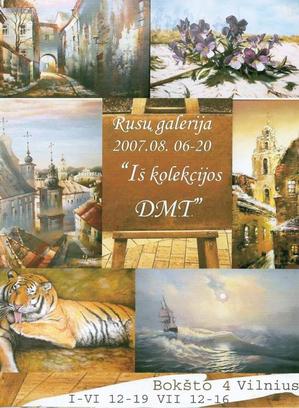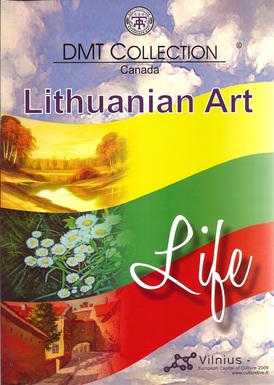 DMT Collection Exhibition 2007
DMT Collection Exhibition 2007 THE FIRST ART EXHIBITION WAS HELD ON AUGUST 6, 2007.
IT WAS NAMED “ART FROM D.M.T. COLLECTION”, SHOWING A RELATIVELY SMALL PORTION OF COLLECTED ARTWORKS.
ONLY 44 PAINTINGS WERE PRESENTED IN THE RUSSIAN ART GALLERY LOCATED IN THE OLD TOWN OF VILNIUS.
THE EXHIBITION CONTINUED FOR TWO WEEKS AND WAS A CONSIDERABLE SUCCESS, WITH MORE THAN 420 VISITORS.
IT WAS SHOWN ON NATIONAL TELEVISION ON AUGUST 6 ON LITHUANIAN NEWS.
ALL MAJOR RADIO REPORTERS WERE PRESENT AT THE EXHIBITION, INCLUDING LITHUANIAN RADIO AND RUSSIAN RADIO – LITHUANIA. OUR INTERVIEW WITH THEM WAS BROADCASTED ON AUGUST 6 AND 7 IN TWO LANGUAGES: RUSSIAN AND LITHUANIAN.
Exhibition review by Liudmila Buchneva
Director of the Lithuanian Public Institution “ Meno Iniciatyva – Art Initiative”
At the end of the summer of 2007 an exhibition took place in Vilnius Russian Art Gallery in which a number of paintings from the DMT collection were displayed. First of all, let us make an observation: for the organizers of this exhibition, the term “Lithuanian Art” meant one thing: the art of creative painters of the state of Lithuania, regardless of their ethnic belonging. Actually, it is and has always been as follows: geniuses and talents of most different blood are intertwined in each culture: the Russians have Pushkin, Levitan, Repin… The list of examples may be continued and continued.The exhibition aroused great interest and information about it was twice shown on Lithuanian TV channels. It was visited by a large number of people, the majority of whom made enthusiastic comments. This interest is understandable as the DMT collection is unique already by its very intention. The organizer made an attempt to present that modern art of Lithuania which is well-known to the broadest circle of spectators, demanded and loved by it. We may say that the DMT collection (in the version it exists in at the moment) is a mirror of today’s Lithuanian society: It precisely fixes the society’s aesthetic and thematic preferences.
Having cast a glance on the exhibition as a whole, I want to say one thing: how wonderful that such a collection exists. Whatever the road the collector would take further on; the DMT collection will be of interest not only for the buyers, spectators and art critics but also for sociologists and historians of culture.
Vilnius, September 2007
IT WAS NAMED “ART FROM D.M.T. COLLECTION”, SHOWING A RELATIVELY SMALL PORTION OF COLLECTED ARTWORKS.
ONLY 44 PAINTINGS WERE PRESENTED IN THE RUSSIAN ART GALLERY LOCATED IN THE OLD TOWN OF VILNIUS.
THE EXHIBITION CONTINUED FOR TWO WEEKS AND WAS A CONSIDERABLE SUCCESS, WITH MORE THAN 420 VISITORS.
IT WAS SHOWN ON NATIONAL TELEVISION ON AUGUST 6 ON LITHUANIAN NEWS.
ALL MAJOR RADIO REPORTERS WERE PRESENT AT THE EXHIBITION, INCLUDING LITHUANIAN RADIO AND RUSSIAN RADIO – LITHUANIA. OUR INTERVIEW WITH THEM WAS BROADCASTED ON AUGUST 6 AND 7 IN TWO LANGUAGES: RUSSIAN AND LITHUANIAN.
Exhibition review by Liudmila Buchneva
Director of the Lithuanian Public Institution “ Meno Iniciatyva – Art Initiative”
At the end of the summer of 2007 an exhibition took place in Vilnius Russian Art Gallery in which a number of paintings from the DMT collection were displayed. First of all, let us make an observation: for the organizers of this exhibition, the term “Lithuanian Art” meant one thing: the art of creative painters of the state of Lithuania, regardless of their ethnic belonging. Actually, it is and has always been as follows: geniuses and talents of most different blood are intertwined in each culture: the Russians have Pushkin, Levitan, Repin… The list of examples may be continued and continued.The exhibition aroused great interest and information about it was twice shown on Lithuanian TV channels. It was visited by a large number of people, the majority of whom made enthusiastic comments. This interest is understandable as the DMT collection is unique already by its very intention. The organizer made an attempt to present that modern art of Lithuania which is well-known to the broadest circle of spectators, demanded and loved by it. We may say that the DMT collection (in the version it exists in at the moment) is a mirror of today’s Lithuanian society: It precisely fixes the society’s aesthetic and thematic preferences.
Having cast a glance on the exhibition as a whole, I want to say one thing: how wonderful that such a collection exists. Whatever the road the collector would take further on; the DMT collection will be of interest not only for the buyers, spectators and art critics but also for sociologists and historians of culture.
Vilnius, September 2007




 RSS Feed
RSS Feed